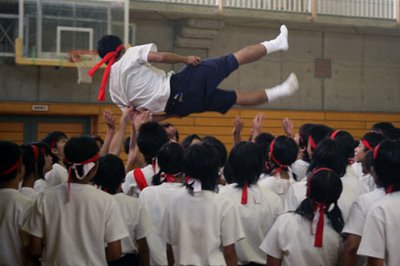 Jidai Matsuri, Kyoto`s Festival of Ages, started as a way to revitalize Kyoto after Japan's capitol moved to Tokyo. It has now grown to include over two thousand participants (Kyoto residents, including Maiko and Geiko) dressed in authentic period costumes from throughout Japan`s history valued at over $25 million.
Jidai Matsuri, Kyoto`s Festival of Ages, started as a way to revitalize Kyoto after Japan's capitol moved to Tokyo. It has now grown to include over two thousand participants (Kyoto residents, including Maiko and Geiko) dressed in authentic period costumes from throughout Japan`s history valued at over $25 million.Izumo-no-Okuni (1600), the mother of Kabuki, was once a maiden in the service of the Izumo Shrine, one of Japan’s holiest Shinto shrines. She later became famous for her dancing, and legend holds that her troup`s first performance took place in the dry bed of the Kamo River. These dances were very popular (I have been told the originall characters used to write kabuki meant song, dance and prostitution), so popular that the Tokugawa shogunate banned women from the stage. From then on, all roles have been placed by men. Today Kabuki is written with characters meaning song, dance and skill.
Lady Shizuka (played by Masayo, a high ranking maiko from Gion Higashi), a famed Kyoto dancer of the late 12th century,was the lover of the hero Minamoto-no-Yoshitsune, a brilliant Genji general in the Gempei War (1180-1185). His success, however, earned him the distrust of his half-brother, Yoritomo, the leader of the Genji (vs. the Heike). In 1185, Yoritomo forced his half-brother to flee and live like an outlaw.
Four years later, facing capture and certain execution, Yoshitsune committed suicide. Shizuka, pregnant with his child, was captured by Yoritomo. Reportedly, she danced for him and so charmed him that Yoritomo spared her life and that of her unborn child only if it was a girl. Unfortunately, a son was born and soon killed to prevent him from seeking vengeance for his father's death later in life.




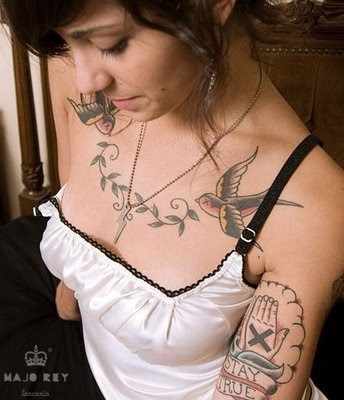






 Colors and patterns of the "juni-hitoe" (12 layers- a rather arbitrary number, as some women wore as many as 20) reflected many things, including: rank, seasons, directions, virtues, and elements of the earth as they related to spirits of nature. The multiple layers also helped in staying warm in winter. Eventually, sumptuary laws of the Edo Period standardized the number of layers to five.
Colors and patterns of the "juni-hitoe" (12 layers- a rather arbitrary number, as some women wore as many as 20) reflected many things, including: rank, seasons, directions, virtues, and elements of the earth as they related to spirits of nature. The multiple layers also helped in staying warm in winter. Eventually, sumptuary laws of the Edo Period standardized the number of layers to five.
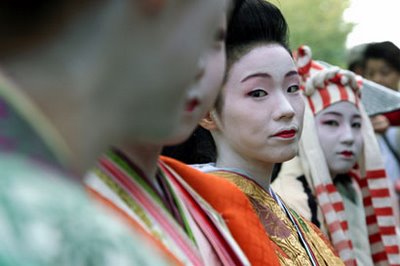


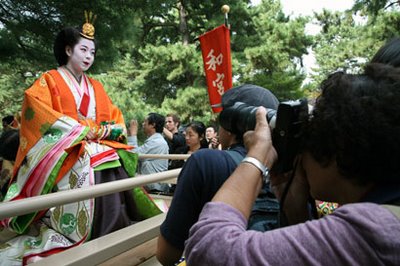

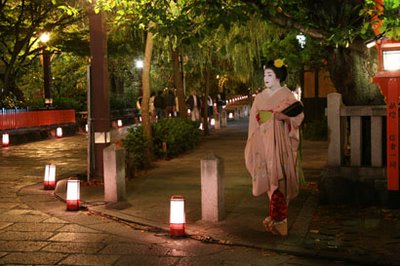
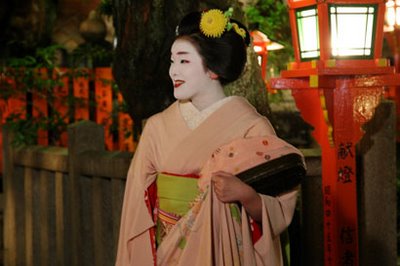
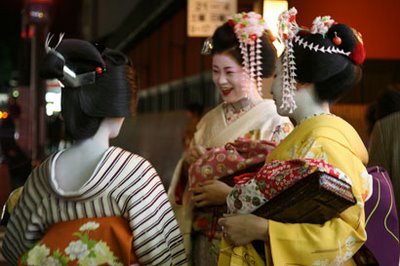
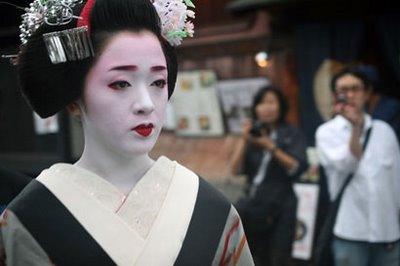 Almost Famous: Kotoha, A young, high rank maiko named Kotoha makes her to the big party at the Ichiriki teahouse after the main procession of Yamahoko Junko last July.
Almost Famous: Kotoha, A young, high rank maiko named Kotoha makes her to the big party at the Ichiriki teahouse after the main procession of Yamahoko Junko last July.  A young, first year maiko on her way to an appointment during Gion Matsuri. Geiko still use traditional, oiled paper umbrella in the rain and snow. This was my first time actually seeing a maiko or geiko use one. Breath-taking. This is also the first image taken with my new camera (^-^)/ I'm still learning how to use it. Non-stop pouring rain + fast moving maiko = a great learning experience! The blur helps conveys the hustle and bustle of the crowded street, the young maiko rushing through the crowd to her appointment, and the dreary, dripping rain. It looks ethereal, like a scene from a dream, which is exactly the way I felt when I shot it.
A young, first year maiko on her way to an appointment during Gion Matsuri. Geiko still use traditional, oiled paper umbrella in the rain and snow. This was my first time actually seeing a maiko or geiko use one. Breath-taking. This is also the first image taken with my new camera (^-^)/ I'm still learning how to use it. Non-stop pouring rain + fast moving maiko = a great learning experience! The blur helps conveys the hustle and bustle of the crowded street, the young maiko rushing through the crowd to her appointment, and the dreary, dripping rain. It looks ethereal, like a scene from a dream, which is exactly the way I felt when I shot it.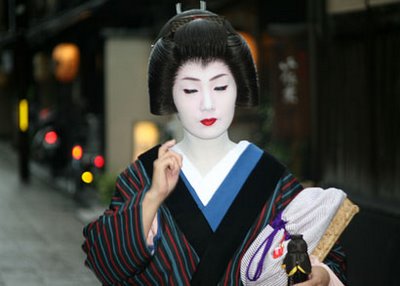 Eyes Wide Closed: Gion. A geiko making her daily communte through the streets of Gion. Geiko wear wigs called katsura, with almost no ornamentation (compared to maiko, who style their own hair, which is adorned with many kanzashi, or flowered ornaments). Of course she blinked the exact moment I pressed the shutter, but what a perfect face.
Eyes Wide Closed: Gion. A geiko making her daily communte through the streets of Gion. Geiko wear wigs called katsura, with almost no ornamentation (compared to maiko, who style their own hair, which is adorned with many kanzashi, or flowered ornaments). Of course she blinked the exact moment I pressed the shutter, but what a perfect face. A young geiko waiting outside the Ichiriki Teahouse in Gion with her client. Customers pay about $200 dollars an hour for the privledge of spending time with geiko (kyoto dialect for geisha), but having money is not the only requirement. Customers must have a relationship with an ochaya, a place where geiko entertain, in order to make an appointment, and being introduced to an ochaya is no simple task. The refined manners of Kyoto dictate that charging a customer at the end of the night is a no-no. With bills often running past 5,000$ a night, Ochaya must have a relationship based on trust, so that they can rest assured that the bills that they send to their customers once a month will be paid.
A young geiko waiting outside the Ichiriki Teahouse in Gion with her client. Customers pay about $200 dollars an hour for the privledge of spending time with geiko (kyoto dialect for geisha), but having money is not the only requirement. Customers must have a relationship with an ochaya, a place where geiko entertain, in order to make an appointment, and being introduced to an ochaya is no simple task. The refined manners of Kyoto dictate that charging a customer at the end of the night is a no-no. With bills often running past 5,000$ a night, Ochaya must have a relationship based on trust, so that they can rest assured that the bills that they send to their customers once a month will be paid.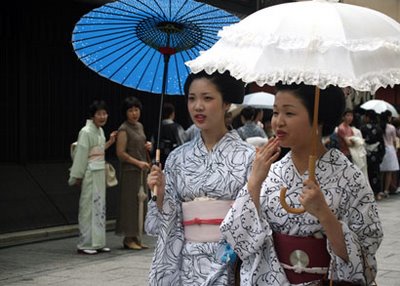


 Fight! The Red Team`s Trendy Takayo makes team spirit fashionable with an English twist on the classic sports festival hachimaki (headband). Running in the rain is no reason to be be kawaikunai yo!
Fight! The Red Team`s Trendy Takayo makes team spirit fashionable with an English twist on the classic sports festival hachimaki (headband). Running in the rain is no reason to be be kawaikunai yo! Good form!
Good form!

 The 3rd year students special event, the "Chain Gang Escape." Ichi ni! Ichi ni! Us teacher^types got cool *staff* shirts with Kitunchu, written on the back, supposedly the Okinawan dialect for people from Honshu. The top character 北、means north. The lower character, 人、means person.
The 3rd year students special event, the "Chain Gang Escape." Ichi ni! Ichi ni! Us teacher^types got cool *staff* shirts with Kitunchu, written on the back, supposedly the Okinawan dialect for people from Honshu. The top character 北、means north. The lower character, 人、means person.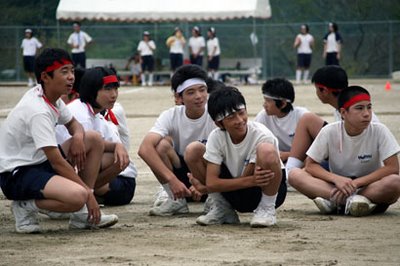
 Note that both of their legs are tied together, as well as to the people behind them. Events like this emphasize acting as "one heart" and "one mind."
Note that both of their legs are tied together, as well as to the people behind them. Events like this emphasize acting as "one heart" and "one mind."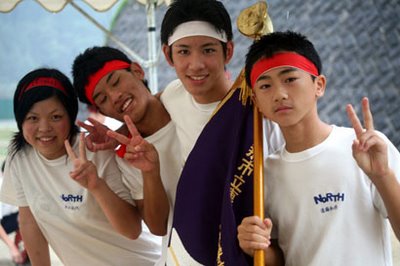
 My girls! Natsuki, Ami, Mio, Takayo, and Ami.
My girls! Natsuki, Ami, Mio, Takayo, and Ami. Another %$#&'$ speech! For God`s sake please stop talking! Its pouring, and my bento awaits!
Another %$#&'$ speech! For God`s sake please stop talking! Its pouring, and my bento awaits!